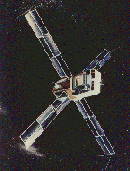|
|
|
|
The Third Small Astronomy Satellite (SAS-3)

he third US Small Astronomy Satellite (SAS-3)
was launched in May 1975, with 3 major scientific objectives: 1)
determine bright X-ray source locations to an accuracy of 15
arcseconds; 2) study selected sources over the energy range
0.1-55 keV; and 3) continuously search the sky for X-ray novae,
flares, and other transient phenomena.
It was a spinning satellite with pointing capability.
Mission Characteristics
 Lifetime : May 1975 - Apr 1979
Lifetime : May 1975 - Apr 1979
 Energy Range : 0.1-60 keV
Energy Range : 0.1-60 keV
 Payload :
Payload :
There are four X-ray experiments on SAS-3 that all used proportional
counters as detectors with different collimating system.
The experiments were not co-aligned.
- Modulation collimators (2-11 keV)
- Slat and Tube collimators (1 up to 60keV)
- Low-energy detector system
0.15-1.0 keV, 2.9° FOV
 Science Highlights:
Science Highlights:
-
Discovery of a dozen X-ray burst sources among which
the Rapid Burster
-
First discovery of X-ray from an highly magnetic WD binary
system, AM Her
- Discovery of X-ray from Algol and HZ 43.
-
Precise location of about 60 X-ray sources
-
Survey of the Soft X-ray background (0.1-0.28 kev)
 Archive : Raw Data in their native format
Archive : Raw Data in their native format
[About SAS-3] (http://heasarc.gsfc.nasa.gov/docs/sas3/sas3_about.html)
[Archive] (http://heasarc.gsfc.nasa.gov/docs/sas3/archive/sas3_archive.html)
[Gallery] (http://heasarc.gsfc.nasa.gov/docs/sas3/sas3_images.html)
[Publications] (http://heasarc.gsfc.nasa.gov/docs/sas3/bib/sas3_biblio.html)
|
|
